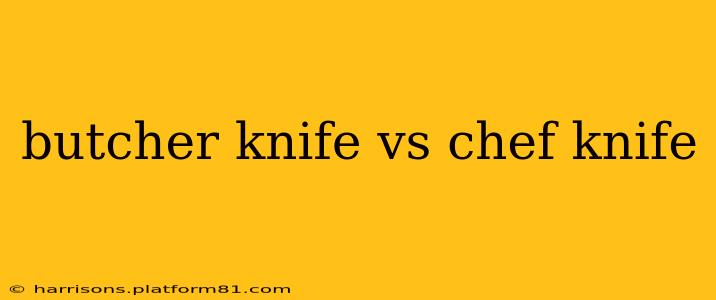Choosing between a butcher knife and a chef's knife can feel like navigating a culinary minefield. Both are essential tools in any serious cook's arsenal, but their distinct designs cater to different needs. This comprehensive guide will dissect the key differences, helping you determine which knife—or perhaps both!—best suits your cooking style and culinary ambitions.
What is a Butcher Knife?
A butcher knife, also known as a breaking knife, is characterized by its long, slender blade, typically ranging from 6 to 15 inches. This elongated shape provides exceptional reach, making it ideal for breaking down large cuts of meat, poultry, and fish. The blade's pointed tip allows for precise cuts, while its robust construction handles tough cartilage and bone with ease. Think of it as your go-to tool for large-scale butchering tasks.
What are Butcher Knives Used For?
- Breaking down large cuts of meat: From whole chickens to hefty roasts, the butcher knife excels at separating bone from meat and portioning large cuts efficiently.
- Deboning: Its length and pointed tip are perfectly suited for navigating around bones and cleanly removing them.
- Slicing through tough cuts: The sturdy blade effortlessly slices through tough connective tissues and gristle.
- Fish butchering: Similarly to poultry and red meat, butcher knives are adept at processing whole fish.
What is a Chef's Knife?
The chef's knife, a kitchen workhorse, features a shorter, broader blade—usually 8 to 12 inches long—with a curved profile. This versatile design makes it adept at a wide variety of kitchen tasks, from mincing herbs to dicing vegetables to slicing proteins. Its curved blade facilitates a rocking motion, allowing for efficient chopping and slicing.
What are Chef's Knives Used For?
- Chopping vegetables: From onions and carrots to peppers and more, the chef's knife is the undisputed champion of vegetable preparation.
- Mincing herbs: Its shape is well-suited to finely chopping delicate herbs.
- Slicing meat and poultry: While not as adept at breaking down whole carcasses, a chef's knife is efficient for slicing cooked meat and poultry.
- General-purpose use: Its versatility makes it a reliable tool for a wide range of kitchen tasks.
Butcher Knife vs. Chef Knife: Key Differences Summarized
| Feature | Butcher Knife | Chef's Knife |
|---|---|---|
| Blade Length | 6-15 inches | 8-12 inches |
| Blade Shape | Long, slender, pointed tip | Shorter, broader, curved |
| Primary Use | Breaking down large cuts of meat, deboning | General-purpose chopping, slicing, mincing |
| Strength | Very strong, designed for bone contact | Strong, but not designed for heavy bone work |
| Versatility | Less versatile | Very versatile |
Which Knife Should I Choose?
The "best" knife depends entirely on your needs.
-
Home Cooks: A good quality chef's knife will likely suffice for most home cooking tasks. Its versatility makes it a valuable addition to any kitchen.
-
Serious Home Cooks/Aspiring Chefs: Investing in both a chef's knife and a butcher knife provides a comprehensive set of tools for a wider range of culinary projects.
-
Butchers/Professional Chefs: A butcher knife is an indispensable tool for professionals regularly working with large cuts of meat.
What Size Knife Do I Need?
The ideal size for both butcher and chef knives will depend on your hand size and the types of food you typically prepare. Larger hands might benefit from slightly larger blades, while smaller hands might find larger blades cumbersome. For chef's knives, an 8-inch blade is often considered the optimal size for most users. For butcher knives, a 10-12 inch blade is frequently favored for versatility.
Are there alternatives to a butcher knife?
While a butcher knife is specialized, a large cleaver can sometimes serve a similar purpose, particularly for breaking down bones. However, the cleaver's heft and different design make it less suited to precise deboning tasks.
This detailed comparison should empower you to make an informed decision about which knife—or knives—will best enhance your culinary skills and kitchen experience. Remember, quality is crucial; investing in well-crafted knives will ensure years of reliable service.
